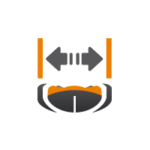1- Boat width.
 You need to know the width of your boat: this measure is important because it is essential to determine the length of your paddle. There is a multitude of Kayak on the market, however it is easy to determine 3 sizes:
You need to know the width of your boat: this measure is important because it is essential to determine the length of your paddle. There is a multitude of Kayak on the market, however it is easy to determine 3 sizes:
small: from 48 to 55 cm
medium: from 57 to 63 cm
wide: from 65 cm
Attention: the values shown in the table of choice at the bottom of the page are those for vessels corresponding to the medium category. You must reduce these dimensions by 5 cm if your boat belongs to the category “small” or increase it by 5 cm if your boat belongs to the category “large”.
2- Your size
 The size is also decisive for the length of the paddle. If you measure between 1m55 and 1m65, your paddle will be smaller than a person measuring between 1m75 and 1m85; and if you measure more than 1m90, your paddle will be even bigger. Whatever type of boat you are using.
The size is also decisive for the length of the paddle. If you measure between 1m55 and 1m65, your paddle will be smaller than a person measuring between 1m75 and 1m85; and if you measure more than 1m90, your paddle will be even bigger. Whatever type of boat you are using.
We offer two adjustment systems that allow you to change the length of your paddle (S-lock system and fast-lock system)
3- Your paddling style
2 different styles:


“high angle” > the paddle is close to the hull of the boat, the directional stability is good. This is the dynamic paddle: the rates are high and the search for support is important. The power is the goal to do either fast maneuvering, physical training, or evolve under difficult conditions. It is a bit the European style taught in many paddle schools.
“Low angle” > the water intake is more soft and the rates are lower. The movement of the paddle is more circular. directional stability on boats without drift or rudder is less good. A less tiring style for muscles and joints on long exits. Very good also against pathologies of back pain. The “low angle” style comes from North America.
4- Blade size
 This is based on the level of the paddler and its physical condition:
This is based on the level of the paddler and its physical condition:
Large: for powerful paddlers and in good physical condition.
Medium: the most representative size is the most versatile size.
This can be compared to the bike gear: a wide blade takes a lot more water and the Cadence will be lower and therefore require more power. With a medium blade, the Cadence can increase without having a strong power to develop.
5- Blades feather
 What’s the point?
What’s the point?
We owe this crossing angle to the race kayak racers online. They found that the blades forming an angle of 90 ° in relation to each other offered significantly less aerodynamic resistance than the air blade. This advantage was even more pronounced by face wind or much of the paddle’s energy was lost to push air-not to mention the decrease in Cadence due to this resistance.
After decades of crossing at 90 °, the angles were reduced to:
60 ° on almost all touring paddles
55 ° in race online
45 ° on white water paddles.
This decrease in angle made the paddle more comfortable: the 30 ° and 45 ° less allowed to limit the movement of the wrist (mainly right) responsible for the swivel.
Crossed left or right crossed?
90 people are crossed right.
For the left Crusaders, don’t panic we realize these paddles on demand.
The Vario S-lock system also offers the possibility of adjusting the crossing angles.
6- The handle.
The right sleeve remains the most used. The location of the hands is free throughout its length.
The ergonomic handle allows to keep the alignment of the arm with the hand.
This translates into fewer joint stresses on the wrist and much more contact surface on the handle. It’s a comfortable grip. We recommend this type of handle on the paddles of “touring” to experienced paddlers who master their hand placement perfectly, because the reduced ergonomic area imposes a very precise positioning.
On “white water” paddles, usually less than 2 meters in length, hand placement is much more instinctively, and the ERGO handle can provide ease of use from the first uses.
7- Paddle fixed or adjustable length.
Some purists swear by the fixed paddles: we were in this case before developing our own adjustable sleeves. Most of the proposed systems lack reliability in rotating deadlocks. Our unique manufacturing technology allows us to maintain the bending values of our tubes despite the manchonnage. From this observation, we have developed our own adjustment systems and especially developed adjustable tubes with constant bending. We therefore offer fixed paddles and adjustable paddles (3 systems):
Fixed or Mono: this option means that you have a fixed paddle without adjusting adjustment system. The length and angle are unique.
Vario S-lock: the Vario S-lock offers 10 cm adjustment and an infinite crossover angle choice. It also allows to adjust its paddle with a greater finesse. This option is recommended for all paddlers who want to configure their paddle in an extremely safe way.
Vario s-lock 2: new adjustment system, the Vario S-lock 2 is an evolution of the S-lock system. Lightweight and compact, the S-lock 2 Vario works without tools. It offers the same range of adjustment (10 cm) as the Vario S-lock with an infinite crossover angle choice. Extremely fast to use, it allows to adjust its paddle with an extreme finesse. This option is recommended for all paddlers who want to set up their paddle regularly.
Fast lock: the fast-lock offers 9 cm adjustment in intervals of 3 cm. It allows to quickly adjust the length of its paddle without changing its angle of crossing. This option is recommended for all paddlers wishing to have a removable paddle without worrying about the crossing angle.
8- Oval tube or round tube
T

he ovalizer has no obligatory character, but provides extra comfort on the hand that controls the crossing; usually the right hand. It is also a plus in difficult conditions (Eskimo, navigation in the current Fort, etc…) where it is difficult to know how the hand is placed relative to the blade. On our sleeves, the ovalisation is carried out by the shape of the tube: the ovalizer is integrated in the handle.
“Racing” paddles are delivered without an ovalizer. However, you can ask for them as accessories. We strongly advise not to add an ovalizer to the competition paddles, so as not to disturb the paddle stroke.
9- Your kayak practice.
Obviously, the last parameter remains mainly your choice of practice of the discipline: you have already had to answer it when acquiring your kayak or canöe.
At the kayak level, 3 practices are distinguished:
Touring: practice of river or sea hikes;
White water: practice in whitewater;
Online race: competitive practice.
3 tables based on navigation practices have been established.
These tables are fairly accurate in their recommendations, so you can use them with confidence to choose your paddle.

Choose your touring paddle
The values shown in this table are those for vessels corresponding to the medium category. You need to reduce these dimensions by 5 cm if your boat belongs to the category “small”, or increase it by 5 cm if your boat belongs to the category “large”.
Touring paddle high-angle
User size length paddle paddle patterns
adjustable fixed
152 > 160 cm 205 200 > 210 X.tr-x. blade x. Trek-x. fiber-x. one
162 > 170 cm 210 205 > 215 X.tr-x. blade x. Trek-x. fiber-x. one
172 > 180 cm 215 210 > 220 X.tr-x. blade x. Trek-x. fiber-x. one
182 > 190 cm 220 215 > 225 X.tr-x. blade x. Trek-x. fiber-x. one
192 > 200 cm 225 220 > 230 X.tr-x. blade x. Trek-x. fiber-x. one
Low-angle touring paddle
User size length paddle paddle patterns
adjustable fixed
152 > 160 cm 210 205 > 215 X.tr-x. blade x. Trek-x. fiber-x. one
162 > 170 cm 215 210 > 220 X.tr-x. blade x. Trek-x. fiber-x. one
172 > 180 cm 220 215 > 225 X.tr-x. blade x. Trek-x. fiber-x. one
182 > 190 cm 225 220 > 230 X.tr-x. blade x. Trek-x. fiber-x. one
192 > 200 cm 235 230 > 240 X.tr-x. blade x. Trek-x. fiber-x. one
 Choose your white water paddle
Choose your white water paddle
The size of the paddle depends a lot on the type of boats used. The volume is to be taken into consideration: a short paddle will be interesting for beginners and Rodeo (difficult to make tricks with a bulky paddle). A shorter paddle will give more power in difficult rivers, where maneuvering will have to be very accurate. This table is a help, and is by no means anything to impose. It simply reflects the trend of practice on the world market.
Advice for low volume vessels: consider the first value recommended in red.
Paddle white water
User size length paddle paddle patterns
fixed adjustable
ergonomic right
152 > in 160 cm 185
194 188 > 198 186 > 190 Warrior-pulse-blast-W1-impact ride
162 > in 170 cm 188
197 191 > 201 188 > 192 Warrior-pulse-blast-W1-impact ride
172 > in 180 cm 191
201 191 > 201 192 > 196 Warrior-pulse-blast-W1-impact ride
182 > in 190 cm 194
204 194 > 204 194 > 198 Warrior-pulse-blast-W1-impact ride
192 > in 200 cm 197
207 194 > 204 190 > 200 Warrior-pulse-blast-W1-impact ride
 Choose your canoe paddle
Choose your canoe paddle
Here’s a simple way to measure how long a canoe paddle is.
Sit on a Chair or on the floor, and measure the distance between your eyes and the seat. This measure will help you choose your paddle in the following table. Attention this is only a way to validate an approach; the best thing to choose a paddle, if you have the opportunity, is to give it a try.
Canöé paddle
Measured length paddle blades wide blades medium
adjustable fixed
66 > 67 cm 130-C1 C1
71 > in 72 cm 135
140-C1 C1
76 > in 77 cm 140
145 140 > 150 C1 C1
81 > in 82 cm 145
150 145 > 155 C1 C1
85 > in 88 cm 150
155 150 > 160 C1 C1
90 > 91 cm 160 155 > 165 C1 C1
95 > 97 cm 165 155 > 165 C1 C1


